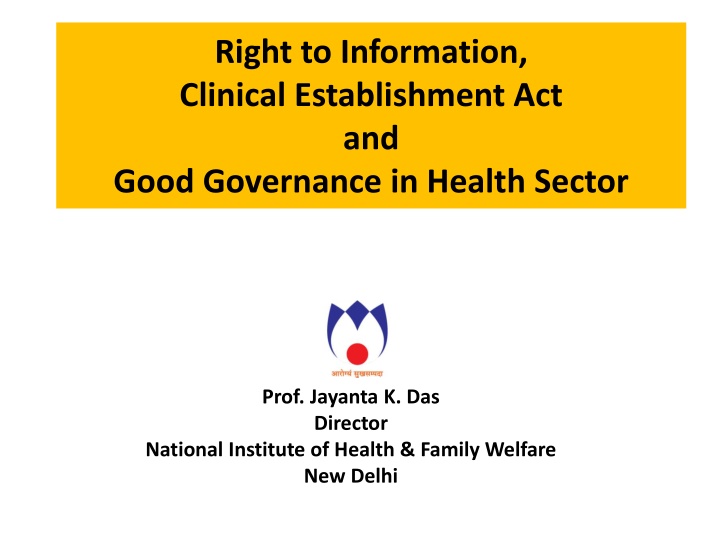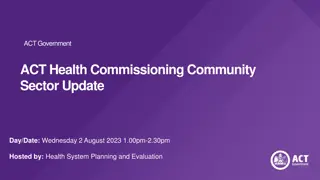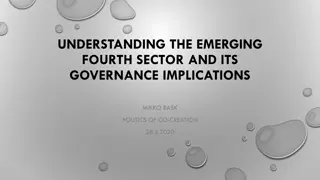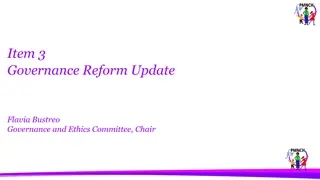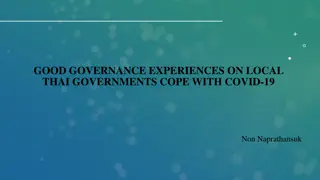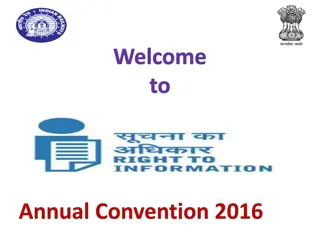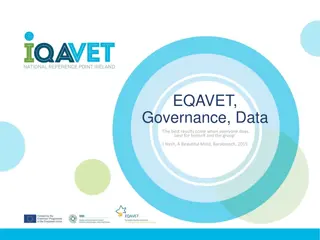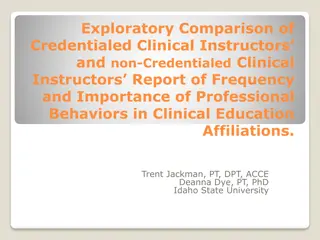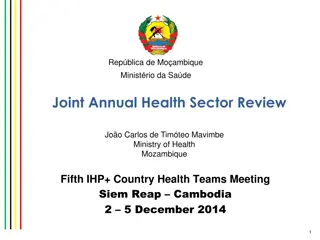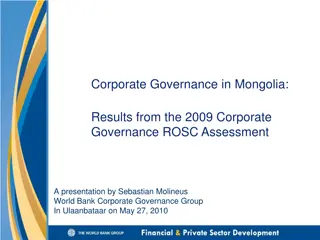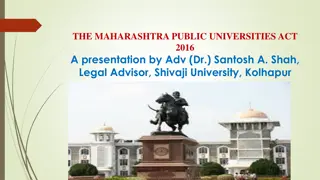Good Governance in Health Sector and Clinical Establishment Act
This content discusses the importance of good governance in the health sector, focusing on initiatives like the Clinical Establishment Act and the need for legislation to regulate clinical establishments. It also highlights the significance of transparency, accountability, and setting standards for healthcare services. Furthermore, it emphasizes the role of collaborative governance, citizen engagement, and adaptive policies for enhancing health governance.
Download Presentation

Please find below an Image/Link to download the presentation.
The content on the website is provided AS IS for your information and personal use only. It may not be sold, licensed, or shared on other websites without obtaining consent from the author.If you encounter any issues during the download, it is possible that the publisher has removed the file from their server.
You are allowed to download the files provided on this website for personal or commercial use, subject to the condition that they are used lawfully. All files are the property of their respective owners.
The content on the website is provided AS IS for your information and personal use only. It may not be sold, licensed, or shared on other websites without obtaining consent from the author.
E N D
Presentation Transcript
Right to Information, Clinical Establishment Act and Good Governance in Health Sector Prof. Jayanta K. Das Director National Institute of Health & Family Welfare New Delhi
Smart Governance for Health and Well being Based on review of case studies, WHO identified five types of smart governance for health which are: 1. Governing by collaborating 2. Governing by engaging citizens 3. Governing by mixing regulation and persuasion 4. Governing through independent agencies and experts bodies 5. Governing by adaptive policies, resilient structures and foresight 3
Major Steps for good governance in Health sector by GOI In the context of good governance in health, one of the important initiative taken by Govt. of India is Clinical Establishment Act, 2010 covering both public and private sectors with aim of: regulation of clinical establishments, preventing quackery, setting minimum standards of facilities & services and enhancing transparency and accountability. Other important tool for good governance and enhancing accountability and transparency covering all government sectors including health is RTI act 2005. 4
Need for Legislation Need for a central legislation for registration of clinical establishments in the country and setting uniform standards highlighted in the report submitted by the Government of India, planning commission namely "Clinical Establishments, Professional Services Regulation and Accreditation of Health Care Infrastructure" for the 11th Five-Year Plan Article 47 (constitution of India), Directive Principle of State Policy mandates improvement in public health Health regulation is the contentious and unresolved issue Unprecedented growth of private sector but largely unregulated and uncontrolled No systematic collection of information from private health establishments In India, out-of-pocket payments still account for a very large share, 59 71% of total health spending. Most such payments are made to private providers. 5
Contd. Majority of states did not have any legislations or having outdated one which were ineffective and/or not being implemented. Ensuring uniform minimum standards of facilities and services by the clinical establishments throughout the country. Concerns about how to improve health care quality - continue to be frequently raised by general public and a wide variety of stakeholders, including associations, private providers, agencies financing health care, Human Rights Commission and judiciary amongst others Despite many State Legislatures having enacted laws for regulating health care providers, the general perception is that current regulatory process for health care providers in India is inadequate or not responsive to ensure health care services of acceptable quality and prevent negligence. Government, professional 6
Clinical Establishment Act Act passed by Parliament : 17th August 2010 Act Notified on 1st March, 2012. National Council notified: 19th March, 2012 Central Rules notified : 23rd May, 2012 Vide the notification dated 28 January, 2010 the Act came into force in four states of India, namely Arunachal Pradesh, Himachal Pradesh, Mizoram, Sikkim and all Union Territories. Later, Uttar Pradesh, Rajasthan and Jharkhand have adopted the Act under clause (1) of article 252 of the Constitution. In 2013, the State of Maharashtra planed a multi-stakeholder committee to formulate the Maharashtra Clinical Establishment Act to an important step towards standardization of quality and costs in the private medical sector. Kerala Clinical Establishments (Registration, Accreditation and Regulation) Bill, 2009 is awaiting a go-ahead from the Government to be enforced. 7
Clinical Establishment Act Specific objectives are :- To establish digital registry of Clinical Establishments at National, State and District level. To prevent quackery by unqualified practitioners by introducing registration system, which is mandatory. To improve quality of standardization of healthcare facilities by prescribing minimum standards of facilities and services for all categories of health care establishments (except teaching hospitals,) and ensuring compliance of other conditions of registration like compliance to standard treatment guidelines, stabilization of emergency medical condition, display of range of rates to be charged, maintenance of records etc. health care through 8
Who is included ? A clinical establishment Allopathy and AYUSH owned, controlled or managed by- The Government or a department of the Government; A trust, whether public or private; A corporation (including a society) registered under a Central, Provincial or State Act, whether or not owned by the Government; A local authority; and A single doctor 9
Who is excluded? Does not include the clinical establishments owned, controlled or managed by the Armed Forces States Having Legislation Repeal the Existing Act and Adopt the CEA 2010 by passing a resolution in the state assembly 10
Benefits Comprehensive Digital Registry of clinical establishments Policy formulation Better surveillance, response and management of outbreak & public health emergencies Engagement with private providers Uniform standards for a category Transparency: process of registration & data in public domain. Multi stakeholder participation in institutional mechanisms (National & State Councils, District Registration Authority) Effective Regulation of providers. Improved quality of health care and patient safety Deterrent against quackery Better management of Emergency medical conditions Details of charges, facilities available would be prominently displayed at a conspicuous place at each establishment
Issues and Challenges CEA, 2010 Adoption of the Act by States Slow implementation Lack of Interest and ownership The Act not applicable to Maharashtra, Delhi, Andhra Pradesh, M.P., Manipur, Nagaland, Punjab, Orissa, W.B. (includes 3 metros) Capacity for online registration in districts Dissemination of information and dispelling fears and misconceptions of stakeholders Acceptability by medical associations Multiple clearances already needed by hospitals Court cases Implementation of standards of health personal--- shortage of specialists, nurses and paramedical staff
RTI: Universal Tool of Accountability 1. More than 100 countries have enacted Freedom of Information (FOI) or Right to Information (RTI) legislation guaranteeing citizens the right to access information and records held by their Governments. 2. In South Asia, over the last decade, countries have made significant progress towards recognizing this right. 3. Indian Parliament enacted the Right to Information Act or RTI Act in June 15, 2005. It extends to all state except J&K. 13
Right to Information Act, 2005 It Provides right to information for citizens to secure information under the control of public authorities in order to promote transparency. Accountability in the working of every public authority for matters connected therewith or incidental thereto. Right to information (RTI) is harnessed as a tool for: promoting participatory development, strengthening democratic governance (Stewardship, adherence to rule of law, transparency, accountability, predictability and participation) and facilitating effective delivery of socio-economic services. Moreover, good governance is bottom up approach rather than top down and is always consensus oriented & responsive to the needs of the citizens. 14
Role of RTI or Transparency in Health Sector To make available the health & health related information to all key stakeholders in the health sector for betterment of health outcomes that is ensuring best quality health care at minimum cost to all beneficiaries. Transparency is required: To generate awareness among consumers regarding health provider costs and quality. Transparency on price, quality, safety, and coverage options can help reduce health costs and improve outcomes by empowering consumers to make better choices. For better accountability in terms of financial management, performance, To enhance the health care services in terms of accessibility, availability, affordability with equitable distribution. 15
Role of RTI in Health Decentralization of health care decision-making promises greater participation by involving citizens in setting priorities, monitoring service provision, and finding new and creative ways. Two types of Participation 1. Guided participation as an underlying determinant of health, related with disease conditions, nutrition, housing, healthy occupational and environmental conditions etc alongwith access to health-related education and information. Participation occurs under the direction of health providers to "reduce individual illness or improve the individual's environment. 2. Freely expressed will of the people to determine their own decisions as per economic, social and cultural systems. Citizens are decision-making stakeholders who have a say at every level, from where resources are allocated to logistical planning 16
Lack of Transparency or transparency failures Lack of transparency in health sector can lead to the situations like what happened in Gorakhpur. 17
Key stakeholders for Transparency Patients /health seekers Health councils and hospital boards, professional associations, unions, health care providers (facilities and individuals, public and private) Political agencies: Parliament; Health Ministry; Executive bodies: Implementers of the Various Public health Acts and Laws; local government officials Judiciary: interpretation of existing laws and reviewing the matters of public health importance suo moto (environmental protection, green initiative etc.) Funding agencies and international donors. 18
Three main strategies for enhancing transparency and accountability in health sector Reducing abuse: It focuses on containment of fraud, misuse, and corruption Assuring compliance with procedures and standards: It involves regulation, oversight, monitoring and reporting requirements. Sources of sanctions include the country s legal framework and judicial system, administrative rules and operating procedures, markets and quasi-markets, professional norms and ethics, licensing and accreditation, and sociocultural values Improving performance/learning: It includes chains of accountability to determine more precisely who is responsible for what, shortening the chains to make feedback on performance more direct and more timely, and/or making the chains more powerful to increase incentives for responsive performance 19
Role of RTI or Transparency in health sector could be understood under five broad categories 1. Administrative framework 2. Medical Care and Cure 3. Medical Ethics 4. Legal Aspects or Constitutional rights 5. Public Health Acts 20
1. Administrative framework Administrative functioning of the Government in health sector is being made DIGITAL to enhance the efficiency and transparency of its functioning. National Health Policy -2017 is also emphasizing on Electronic Health records and to evolve National Health resource Repository. E- office / E-governance Online grievance redressal mechanism PFMS (Public financial management system) Web page of hospital Clear cut Policy for transfers, postings and promotions 21
Administrative framework contd E-procurement -Learning from the best practices in India:- A. Tamil Nadu follows a centralized offline procurement system to purchase essential drugs, specialty drugs, surgical items, sutures, veterinary drugs and equipment. TNMSC acts as a mediator, negotiating prices. The government of Tamil Nadu sanctions a specific annual budget, with no provision of advance payments. The payment is made after half the ordered quantity is received. Equipment is only paid for after the purchased item is installed properly at the required premises. All payments are made online. All branded drugs are procured centrally, through direct negotiations with the manufacturers. These negotiations are based on current market prices and quoted rates. Essentials drugs are supplied free of cost to all public healthcare facilities, while other drugs are sold at subsidized rates through centres at government health institutions. 22
E - procurement B. Kerala Medical Services Corp. Ltd (KMSCL) is yet another efficient procurement system, with a coherent decision- making structure and strict regulatory systems. C. Madhya Pradesh Public Health Services Corp. Ltd is a public corporation that acts as the central procurement agency for essential drugs and equipment for public healthcare institutions in the state. The company is also entrusted with setting up and running medical and paramedical ancillary facilities pathological labs, diagnostic centres and X-ray facilities. such as hospitals, 23
E - Procurement D. West Bengal government saved more than Rs706.34 crore by adopting a fair procurement system in 2014 that included free drug facilities, a fair price medicine shop, free diagnostic facilities and dialysis services. It did so through a public- private partnership. A dedicated Web-enabled software, Store Management System, was introduced to generate procurement orders against fund processing of orders and bills has been disallowed in the state. Information allotments. Manual 24
2. Medical Care and Cure Standard guidelines and accreditations for quality services IPHS Kayakalp assessment NABH & NABL JCI ISO certification Patient Safety Culture / guidelines Standard treatment guidelines Do s and Don ts Patients Roles & Responsibilities Citizen Charter 25
3. Medical Ethics Medical ethics is involved in: 1. Clinical Human Trials 2. Sex determination and illegal abortions ( violation of PC PNDT Act) 3. Stem cell storage and transplantations 4.Monopoly of Private health sector in over-charging for various medical services like consultation, investigations, medicines, implantations, etc. in-situ stents, 26
Medical Ethics Awareness regarding the right to health and medical ethics among the stakeholders is of paramount importance. Strict disciplinary proceedings or actions to be taken for violations of medical ethics by Regulatory Boards Professional Bodies Hospital Committees Executive Bodies Role of Judiciary 27
4. Legal Aspects or Constitutional Health Rights 1. Article 21 of the Constitution of India guarantees a fundamental right to life & personal liberty. Article 21 should be read with other Articles to understand the nature of the obligation of the state in order to ensure the effective realization of this right. Spectrum of Article 21 is broad and covers other rights also which add to the quality of life, for e.g., Right to Health Right to Medical Care Right to die (Euthanasia is partially legal in India) 28
Legal Aspects or Constitutional Health Rights Right to Privacy-Woman s Right to Make Reproductive Choices: right to refuse participation in sexual activity or insistence on use of contraceptive methods such as undergoing sterilization procedures and woman s entitlement to carry a pregnancy to its full term, to give birth and subsequently raise children. Disclosure of Dreadful Diseases covered under Right to Know or Right to Be Informed eg: HIV status of a person was disclosed to the lady whom the person was going to marry by the treating doctor and the Court upheld that right to life included right to healthy life so as to enjoy all the facilities of the human body in the prime condition it was held that the doctors had not violated the right to privacy. 29
Legal Aspects or Constitutional Health Rights 2. Articles 38 impose liability on state that state secure a social order for the promotion of welfare of the people but without public health we can t achieve it. 3. Article 39(e) relates with workers to protect their health. 4. Article 41 imposed duty on state to public assistance basically for those who are sick & disable. 5. Article 42it s a primary responsibility of the state to protect the health of infant & mother by maternity benefit. 6. Article 47 spell out the duty of the state to raise the level of nutrition & the standard of living of its people as primary responsibility. (Directive Principles of State Policy) Some other provisions relating to health are The state shall in particular, direct its policy towards securing health of workers. State organized village panchayats & give such powers & authority to function as units of self government. 30
Protection of Patients Rights : Appropriate Care, Patient Choice All services made available will have to be delivered in accordance with universally accepted standards for patient and user rights, including 1. The Right to Information 2. The Right to Emergency Medical Care 3. The Right to Confidentiality and Privacy 4. The Right to Informed Consent 5. The Right to Second Opinion 6. The Right to Choose between Treatment Options 7. The Right to Refuse Treatment 31
Right to Confidentiality in Healthcare Confidentiality is VITAL in healthcare But is not always an absolute right Exceptions defined by the Medical Council : As it can be the Individual Consents, Required by Statute, Public Interest & If disclosure for relevant and sufficient reason and proportionate. A healthcare professional MUST be able to stand over any breech of confidentiality and it should be a last resort. Duties to inform authorities in certain cases (Child abuse, elderly abuse, public interest) where danger exists, should only be done after careful consideration. All competent persons over 18 have the right to confidentiality- for all other persons healthcare providers must act in the patients best interests 32
Confidentiality and Medical Professional Conduct Confidentiality is a fundamental principle of medical ethics & is central to the trust between patients and doctors 1. Patient information remains confidential even after death 2. To Ensure that the patient s privacy is maintained at all times & that accidental disclosure of confidential information does not occur 3. Ensure that confidential information in relation to patients is maintained securely & in compliance with data protection legislation. 33
Emerging Challenges of Information Disclosure In general, health-care delivery system need to be more patient centered and value-based so that these may be essential steps in improving both patient & more so of community health. 1. To achieve ultimate goal of a transformed health-care system - it is the exchange of patient health information. Studies suggests , greater access to patient health information is integral to improving the quality, efficiency, and safety of health-care delivery. 2. However, little progress has been made toward determining how patient health information, both administrative and clinical, may be shared between providers, patients & other stakeholders across the settings of care. 3. And, there is a significant amount of uncertainty about protection, privacy and security of patient health information. 34
RTI & Exemption from Disclosure 1. According to the RTI Act 8(1) , there shall be no obligation to give any citizen, b) Information which has been expressly forbidden to be published by any court of law or tribunal or the disclosure of which may constitute contempt of court h)Information which would impede the process of investigation or apprehension or prosecution of offenders j)information which relates to personal information 2. RTI Act has inherent tension between conflicting rights i.e. right to privacy, right to autonomy, public interest etc. especially pertaining to medical profession. I. Many situations do come in direct confrontation with RTI as in case of Medico legal Reports, Post-mortem Reports, medical records etc. Many conflicting judgments of CIC, and courts in these matters further confused the issue of RTI and medical profession. II. 3. Denial under good faith, prosecution or other legal proceeding shall lie against any person for anything which is in good faith done or intended to be done under this Act or any rule made there under. 35
Landmark Decision In accordance with the provisions of section 4(1)(b) of RTI Act, the Department of Health and Family Welfare, Government of India has brought out the manual for information and guidance of the stakeholders and the general public. In Selvanathan @ Raghavan and 9 Others vs. State by Inspector of Police, Madras and Others wherein the Full Bench of Madras High Court has held: "... At any rate, R.339 (of the Criminal Rules of Practice) does not postulate that the accused is entitled to copies at any stage. Held that accused are not entitled to certified copies of the Post-mortem certificate, requisition given by the police officers to the Medical Officer for conducting post- mortem and medically treating the injured, before the final report is forwarded to the Magistrate, as contemplated under S.173(2) of the Code . (Denial under good faith) In Veerapan encounter , Madras High court while dismissing the petition filed by the wife of deceased for asking post-mortem report of his husband under RTI held that In consideration of the facts pleaded, having regard to the materials placed on record and upon hearing the learned counsel for the petitioner and the learned Public Prosecutor, High Court, Madras and senior counsel, what this Court could assess is that the petitioner is the wife of Veerapan who was killed along with three others by the Tamil Nadu Special Task Force, no mention need be made that he was wanted in many number of cases ranging from murder to forest offences . (Certified copy of PMR/MLR cannot be issued under RTI and is covered under the Exemption of Section 8(1) (j) of RTI Act as per various decisions of Central Information Commission. In a 12 Jan 2010 judgment by Delhi High Court, a three judge bench decided that medical details of an individual cannot be made public and cannot be given under RTI. Copy of Post-mortem Report (PMR) cannot be given to the claimant wife of deceased held in another landmark case. Copy of Medical Record (MR) cannot be given held by Delhi High Court in January 2010. 36
Learnings from the Case 1. The RTI Act would prevail over an exercise in subordinate legislation such as the MCI Code of Ethics. 2. The health records of a person in police or judicial custody, if admitted to a State or government hospital during the custody, should be made available under the RTI Act, and 3. should be denied only in exceptional cases for good and valid reasons. 37
RTI Cases cited from MoHFW/States The total number of RTI request received by Ministry of Health and Family Welfare in 2013-14 were 22350, of which 373 requestes were rejected.. The annual report of each state Health and Family Welfare Department, has displayed the no. of requests made to each Public Authority, number of decisions where applicants not entitled to access to the documents, and disciplinary Action taken against any officer in respect of administration of the Act, etc. Examples: Punjab: Request Received by Health And Family Welfare, Punjab is 4429. Out of which only 7 cases were rejected in 2015. Tripura: Classification of Information sought by the petitioners Information Seekers (2013-14) from Directorate of health Service, Tripura Service Related information Project Related Information Govt. Scheme related information Govt. Policy related Information Examinatio n related Information Recruitment related Information Any Others 48 9 9 105 17 26 23 38 Source: http://cic.gov.in/sites/default/files/Role%20of%20RTI%20in%20Health%20by%20Mayank.pdf
5. Public Health Acts To enhance transparency and efficiency , the existing Public Health Acts have to be implemented in letter and spirit. Some of these acts are as under:- International Health Regulations Notifiable Diseases Bio Medical Waste Management and Handling Rules, 2016 Drugs and cosmetics act Indian Medical Council Act and Code of Medical Ethics Indian Nursing council Act 39
Public Health Acts Maternity Benefit Act MTP Act Mental Health Act, Pharmacy Act PNDT Act Prevention of Food Adulteration Act The Transplantation of Human Organs Act and Rules Safe Disposal of Radioactive Waste Rules The Water (Prevention and Control of Pollution) Act Registration of Births and Deaths Act 40
Conclusion 1. India has achieved significant achievements in accessing information through Right to Information Act. 2. The provision the of the Act are general and not specifically expressed for health and medical profession and hence subject to interpretation by legal authorities in case of contested interpretation. 3. Therefore, a uniform guideline in accordance with the present provision of the Act or even suggest unequivocal amendments in the Act referring to medical information is required. 4. The rules & regulation laid down in Indian Medical Council Act, and the advantage of RTI Act in the field of Medical Ethics in providing proper Health care to the patients is the need. 5. The RTI Act would prevail over an exercise in subordinate legislation such as the MCI Code of Ethics. The health records of a person in police or judicial custody, if admitted to a State or government hospital during the custody, should be made available under the RTI Act, and should be denied only in exceptional cases for good and valid reasons. 41
Suggestions 1. Awareness and consciousness among the people are the pre-requisites for effective utilization of public services through the Act. To achieve a desired level of awareness must be created on legal and statuary rights and entitlements for effective implementation of RTI Act. 2. Apart from medical skills, Doctors should know about Medical Ethics & Disclosure as process of achieving health. 3. The annual reports uploaded by the all State Information Commissions should be timely update results to enable comparative analysis of the States. 4. Penalties for delays in providing what has been sought under the law are imposed in very rare cases. There must be penalty & effective prosecution system for violating the mandatory provision. 5. Public-Private Partnership arrangements should be brought under the purview of the RTI Act, & be subject to social/audit by the Controller and Auditor General of India. 42
